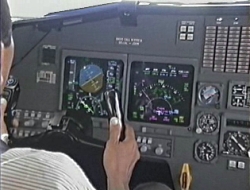SOURCE: Wright State University
International Symposium
on Aviation Psychology
Haslbeck, A., Eichinger,
A., & Bengler, K. (2013). Pilot Decision Making: Modeling Choices in
Go-Around
Situations. 17th
International Symposium on Aviation Psychology, 548-553.
https://corescholar.libraries.wright.edu/isap_2013/23
Part of the Other
Psychiatry and Psychology Commons
SOURCE: FLIGHT SAFETY
FOUNDATION - GO-AROUND DECISION-MAKING AND EXECUTION PROJECT
One important aspect of good airmanship
is pilots’ decision making (FAA, 2004; DeMaria, 2006).
Long-term experience is needed to
build up comprehensive knowledge for an aviator to find appropriate decisions
in a certain situation.
One potentially hazardous situation is
the approach phase, representing more than one-third of all fatal accidents
(IATA, 2011; Boeing, 2012).
CREW FAILED TO GO-AROUND
Two typical
accident categories defined by the
International Air Transport Association are runway
excursions (23% of IATA listed aircraft accidents in 2010) and hard landing (5%).
In-depth analysis has shown, that in 35% of the runway excursions in 2010, meteorology
has been a contributing factor. To complement this information, in one-fourth of all cases, the flight crew has failed to
go-around after an unstabilized
approach (IATA, 2011).
Go-around can be a safe decision to
master the high-risk situation of a hazardous approach.
For types 1 and 2, the time intervals
between different wind checks can be calculated. If a pilot is aware of a wind
potentially differing from the ATC information, he should early perform a first
wind check (t1) in the final approach (below 1,000 ft above ground level) and
should repeat this check continuously until a final decision to (not) go around
is made. The final wind check before the go-around is also measured (t2). If
only one wind check is performed first and last check time coincide (t1=t2).
What are the driving forces for pilots to
consider relevant information sources, i.e. important data displays?
Rasmussen’s classification of action
identifying skill-based, rule-based, and knowledge-based behavior can
help to localize relevant mechanisms (Rasmussen, 1983).
According to O’Hare (2003), “it will be
easier to continue with an existing course of action than to change to a new
one” (p. 223). So, pilots will sometimes tend to
stick to unsuitable skill- or rule-based behavior, where analytical knowledge-based
strategies would be appropriate (O’Hare, 2003).
Research Hypothesis 1: Pilots with a high level of experience will come to "better" decisions
based upon good airmanship.
Research Hypothesis 2: Pilotos not intending to go around
(PnGA) perceive relevant information too late or not
at all.
The first wind check is later for PnGA
than for PGA.
Research Hypothesis 3: Pilots intending to land (PnGA) stick
to a default option up to the point of deciding to choose the default of
landing.
The first wind check is not differing
between PnGA and PGA.
Took part in this research
Pilots with different practices and training.
Twenty-six long-haul captains (CPTs)
flying Airbus A330/340 types participated in the experiment in a full flight
simulator (JAR-STD 1A Level D) with A340-600 configuration and twenty-seven
firs officers (FOs) scheduled on the A 320 short-haul fleet participated in an
equivalent A320-200 full-flight simulator.
Scenario
An uneventful flight from the east to
Munich Airport in the early morning hours. The PF came back from his last rest
about 25 minutes prior to the landing to perform the approach and landing. In
the first phase of the approach, using the autopilot, foreign air traffic
control (ATC) communication (‘party line’) between other approaching aircraft
and the airport could be heard. Pilots’ tasks were to plan, monitor, and communicate. When approaching the instrument landing system, it was the PF’s
decision when to change from autopilot to manual control.
To provoke a hazardous situation, at
1.000 ft. above ground level (AGL), a gentle wind turned into an illegitimate
strong tailwind (16 knots) by a scripted event. The wind information given b ATC
was constantly good over the whole scenario. For pilots, this information given
by ATC is binding. Only the non-binding wind indicator located at the pilot’s
navigation display has shown the real wind strength and direction.
Such a hazardous situation can occur when
the wind turns because the wind information given by ATC is averaged over
several minutes. So, the situation was inexplicit and uncertain for the
participants to make the trade-off between a fuel-saving and economic landing
with a noticeable higher risk or the abort of the approach for a safe second
try (Haslbeck et al., 2012). The chance to go around was given to all
participants until 70 ft. AGL. At this height, the PM was structured to callout
‘go-around’ and abort the approach due to a strong tailwind.
THE RESULTS
The long-haul captains with a lower level of practice and training but a high level of operational experience
show significantly more willingness to land in a risky situation with strong
tailwind than short-haul first officers do.
Interestingly only a small number of
pilots (26 %) would have landed without the PM being instructed to trigger the
go-around in any case. Instructor pilots normally report a higher
tendency to go-around when being in
the flight simulator in comparison to real
flights.
















